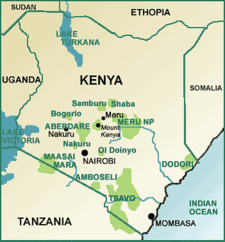story and photos by Christopher Clark
As the bus eased through the gears, through the green corn fields and farther away from the small terminal in the town of Kitale, I tried to cast my mind back to the beginning, to figure out what it was that had drawn me to the wild and volatile Turkana region of Kenya in the first place. I guessed that the people I would meet once I got there might want to know. But the truth was that I still didn't really have an answer.
I could at least have said that it stemmed from books by long-dead explorers; and that I was looking for something very different; and that Turkana seemed a long way away from pretty much everything I had previously known. At 28 years old I had grown bored of and disillusioned with much of what I had previously experienced. Wasn't that enough reason?
Either way, it was too late. I was on my way, heading north, already half way there. Soon the bus rose out of the the Rift Valley and gradually left the rich, thick vegetation behind as we entered a place of sparse open space and scorched earth.

The rumours about the poor quality of the dirt road to Turkana were by no means exaggerated. At times the bus seemed to defy physics, leaning precariously to the side, the ground suddenly almost within touching distance of the window. Many of whom I assumed were the more seasoned passengers whooped, laughed and slapped thighs as though it was all part of the fun. I held on to my armrests for dear life.
A few hours into our journey the bus passed a group of five or six men slouched on the sand with T-shirts covering most of their faces like balaclavas and AK-47s slung over their shoulders. As I stared out of the window at them, one of them saw me, stood up, lifted his gun aloft with one hand and waved at me vigorously with the other, and then they were gone.
We arrived at our destination, Lodwar, at a little before 11 p.m., roughly five hours late. Patience is a must for travelling in Kenya.
